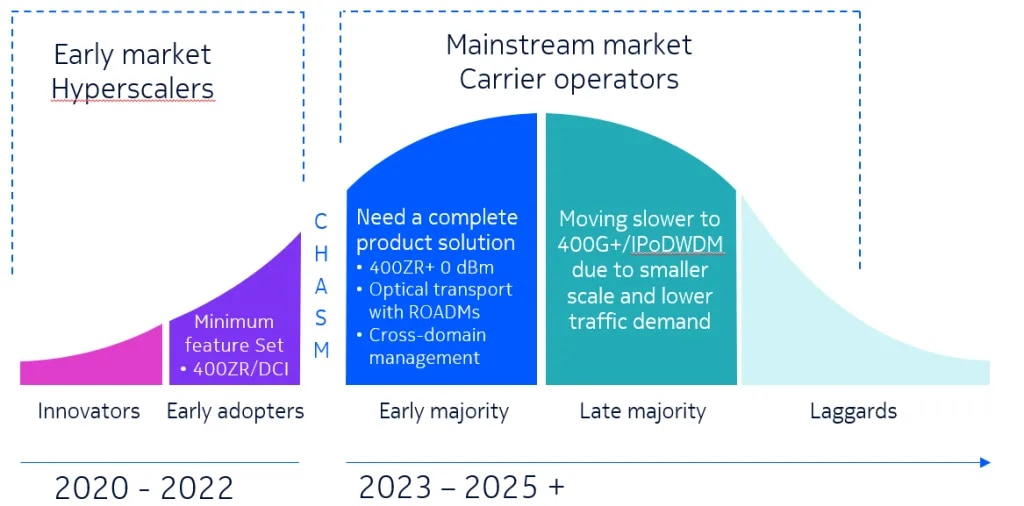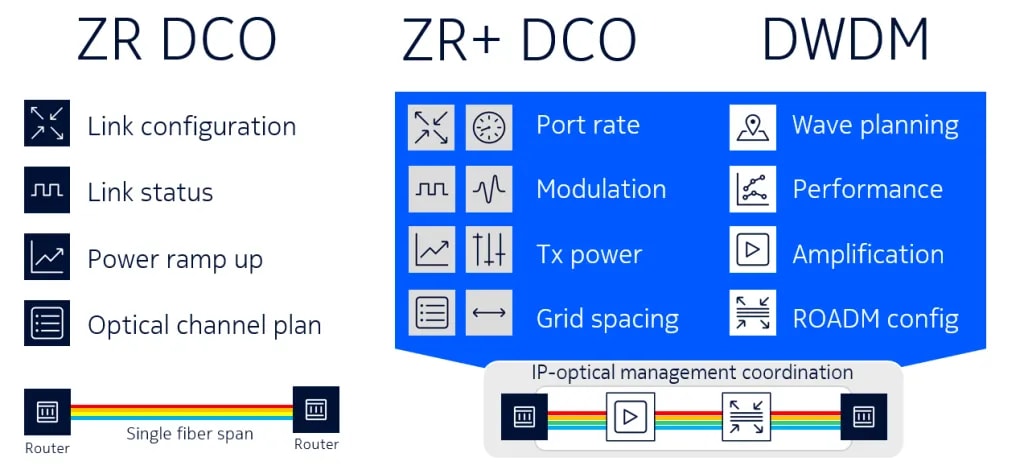Coherent routing for carrier networks

In January 2021, I published my first blog about the potential role of 400ZR and ZR+ pluggable coherent optics in building more efficient IP–optical networks for the 400GE era. At the time, the technology and solutions were nascent but had clear potential. Since then, there has been significant progress on all fronts, and it is time to take stock of how well they address carrier applications.
Coherent routing is coming of age
Like any other technology, pluggable coherent optics went through the rites of passage––the hype, the hope and the harsh reality checks in tests and trials––to prove its worth in real-world network applications.
While the first applications were simple and limited to metro–regional data center interconnect, the use of pluggable profile-optimized digital coherent optics (DCOs) provided significant operational savings. Rack space, power and cooling are precious resources in edge data center facilities because of high real estate costs.
According to a Cignal AI Optical components report, hyperscalers purchased well over 100,000 400ZR DCOs for this purpose between 2020 and 2023. The large demand for 400ZR optics played an instrumental role in driving down cost and funding the development of more DCO options that unlock additional applications, market segments and revenue opportunities:
-
400ZR+ DCOs with higher optical signal-to-noise ratio and transmit power up to 3 dBm unlock a host of carrier applications by enabling optical transport over multi-span metro–regional fiber networks with reconfigurable optical add-drop multiplexers (ROADMs).
-
100ZR DCOs can be equipped in optical line terminals and access aggregation routers for carrier access applications.
-
800ZR/ZR+ DCOs are the next logical step to scale metro–regional data center interconnect and edge/core packet transport.
As a result, pluggable coherent optics technology gained significant momentum to cross the chasm from early adoption into the mainstream market (Figure 1).
Figure 1. Pluggable coherent optics technology is crossing the chasm

Transition into the carrier market
The successful transition of pluggable DCO technology to the mainstream carrier market is not a given. Carriers have different requirements, economies of scale and operational constraints. Their product solution needs are completely different to those of hyperscale data center operators.
Managing 400ZR applications is easy because they are limited to single span, point-to-point fiber applications. There are only a few parameters, such as optical channel frequency and launch power, and these can be auto-configured. It’s basically plug and play.
Metro–regional carrier networks are far more complex because they have very dense connectivity and carry heterogeneous traffic for residential, mobile and business applications. To meet these needs, most carriers deploy flexible optical transport networks with ROADM capabilities to optimally aggregate and transport IP (and OTN) traffic over shared fiber with highly diverse star, ring and mesh topologies.
400ZR+ pluggable DCOs address these multi-span application requirements by supporting multiple bit rates and modulation types, better forward error correction, flexible grid spacing and a much higher launch power than 400ZR pluggable DCOs designed for single-span fiber applications.
To provision wavelengths between routers and optimize fiber capacity and reach, these DCO parameters must be carefully aligned with ROADMs, inline amplifiers and dynamic gain equalizers in the optical transport network (Figure 2).
Figure 2. IP–optical coordination of 400ZR+ applications

Most IP teams do not have the skillset or tools required to properly configure coherent optics. And optical teams are equally blindsided if they do not have management visibility of ZR+ DCOs in the routers or where to connect their wavelengths. Cross-domain management coordination can help IP routing and optical transport teams to deploy IP over DWDM applications correctly and efficiently, while maintaining a clear separation of tasks and responsibilities between teams as usual.
Transition from technology to deployment
Deploying pluggable coherent optics for carrier applications has implications for the existing IP and optical infrastructure, mode of operation, management tools and skills requirements. These implications must be carefully assessed and well understood.
-
Pluggable DCOs are a product of functional disaggregation. Except for a profile-optimized form factor for use in IP routers, they share many commonalities with coherent transponders in optical line systems. Functions move but requirements stay.
-
Pluggable DCOs are an interface component. Their added value for real-world applications depends on how well they integrate with the routers, optical line systems, operational management systems and processes needed to create a complete and deployable solution. The technology, solution and business case must all be validated for a given application.
Over the past few years we have made great progress in testing and validating carrier use cases in our coherent routing blueprint lab. Carrier adoption of pluggable DCO technology is slower because of the number of touchpoints with existing infrastructure, but it is progressing steadily as the potential benefits are clear. At the time of writing, Nokia has well over 30 trials and deployments in various markets and stages of completion.
Our mission is to help operators successfully navigate the challenges of adopting coherent routing technology and get the most out of it. We believe that our unique expertise in IP routing and optical transport is a key asset that can help you manage the learning curve quickly and adopt coherent routing technology successfully for your network.
In subsequent blogs, we will share more insights we learned in our coherent routing projects. For more information, you can check out our coherent routing solution page and this talk by Bruno de Troche at MPLS World!






